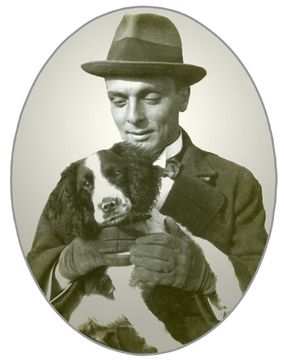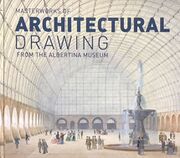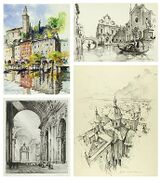Helmut von Wagner-Freynsheim
Helmut von Wagner-Freynsheim | |
|---|---|
 | |
| Born | January 25, 1889 |
| Died | February 16, 1968 (aged 79) Bregenz, Austria |
| Nationality | Austrian |
| Citizenship | Austria |
| Occupation | |
| Spouse(s) | Daisy Faber |
| Children | Diana |
Helmut von Wagner-Freynsheim (25 January 1889 – 16 February 1968) was an Austrian architect and artist known to have built numerous single-family homes, villas, and housing complexes. Some of his architectural drawings, etchings, and watercolors are archived in the Albertina Graphics Museum in Vienna, Austria. One of his architectural drawings is included in a book titled "Masterworks of Architectural Drawing from the Albertina Museum".[1]
Helmut became a gold medalist at the 1935 Brussels Technological Exposition. In the late 1950s, he retired from architecture and returned to painting watercolors of Austria and Italy, as he had done in earlier stages of his career. He died in Bregenz at the age of 79.
Early life and education
Helmut was born on January 25, 1889, to Dr. Jur. Bruno Wagner von Freynsheim, father, and Mathilde Wagner von Freynsheim, mother. His father was the Nordbahn Railways director, and his mother was the daughter of art historian Carl Lützow.
Helmut attended the gymnasium (high school) in Vienna in 1908 and then went to a technical Hochschule (prep school) in Darmstadt, Germany for two years. From another technical high school, this one in Vienna, he received his diploma under Professor König.
Due to his demonstrated talent and abilities, he was accepted into the Vienna studio of Adolf Loos, who was a founding theorist of European modern architecture. Helmut was one of only three students being taught by Loos at the time.
Career
Helmut started his architectural practice in Vienna before the onset of World War I. During the conflict he served in Russia and Turkey. Afterwards, Helmut returned to Vienna, where he made numerous single-family homes and apartment complexes for over a decade. He moved to Kitzbühel (in 1930), then to Leopoldskron near Salzburg (in 1947), to Bezau in the Austrian state of Vorarlberg (in 1949) and finally to Bregenz where he lived from 1951-1968. His underappreciated body of work includes numerous single-family homes, villas, and housing complexes, as well as, on occasion, garden designs. Many of his architectural designs were never realized, in part because his modern design aesthetic was often at odds with more traditional Austrian tastes. Due to his good social contacts, he had many clients from higher social circles. These connections also led to the execution of some significant construction projects in Galicia, now part of Poland.[2]
Helmut’s extensive knowledge and appreciation for architecture was reflected in his etchings, drawing, and watercolors. He drew inspiration from panoramic scenes of mountains, lakes, and cityscapes, as well as narrow alleyways, busy plazas, ornate cathedrals, and rustic villages. His artistic focus from 1924–29 was on producing architectural etchings. These were sold successfully in two galleries in Florence and Milan.[3]
Helmut had the honor of participating in an architecturally progressive model house settlement in Vienna, that opened to the public in 1932, called the Werkbundsiedlung for which he designed two houses designated as Jagdschlossgasse units 69 and 70. The project, directed by Josef Frank, was billed as “the largest building exhibition in Europe” and included designs from other notable architects Josef Hoffman and Adolf Loos.[4]
At the end of World War II, his house in Kitzbühel was confiscated for reasons unknown and he had to move to Salzburg, where he lived for several years working as a watercolourist and painter. The watercolors he painted from the end of WWII until his death were sold in shops and galleries in Vienna, Kitzbühel, and Bregenz, Austria; Sarasota, Florida; and San Francisco, California to name a few. He also became a co-founder of a housing cooperative in Bregenz aimed at helping those in need. In the late 50s, Helmut retired from architecture and returned to painting watercolors. He died in Bregenz at the age of 79.[5]
Awards
At the 1935 Brussels Technological Exposition, Helmut was awarded the highest honor, a gold medal, for a villa he designed for the well-known Viennese art collector, Stephan von Auspitz. He also won a certificate for Villa Auspitz later in Milan. Some of Helmut’s architectural drawings, etchings, and watercolors are archived in the Albertina Graphics Museum in Vienna, Austria. One of his architectural drawings is included in a book published by the Albertina titled “Masterworks of Architectural Drawing from the Albertina Museum.”
Personal life
In the 1920s, Helmut married Daisy Faber, the sister of his office partner,. The marriage produced an only child named Diana, who subsequently married a U.S. Army officer and talented artist named Ted MacKechnie. Their marriage produced two children, Connie and Bruce.
Gallery
References
- ↑ "Helmut Wagner-Freynsheim". English. Retrieved 19 July 2022.
- ↑ "Dipl.-Ing. Helmut Camillo Wagner-Freynsheim". geni_family_tree. Retrieved 19 July 2022.
- ↑ "Helmut Wagner Freynsheim". Wikipedia, la enciclopedia libre (in español). 19 March 2021. Retrieved 19 July 2022.
- ↑ "Werkbundsiedlung Wien – Wikipedia". de-m-wikipedia-org.translate.goog (in Deutsch). Retrieved 19 July 2022.
- ↑ "Copia archivada". wikizero. Retrieved 19 July 2022.

